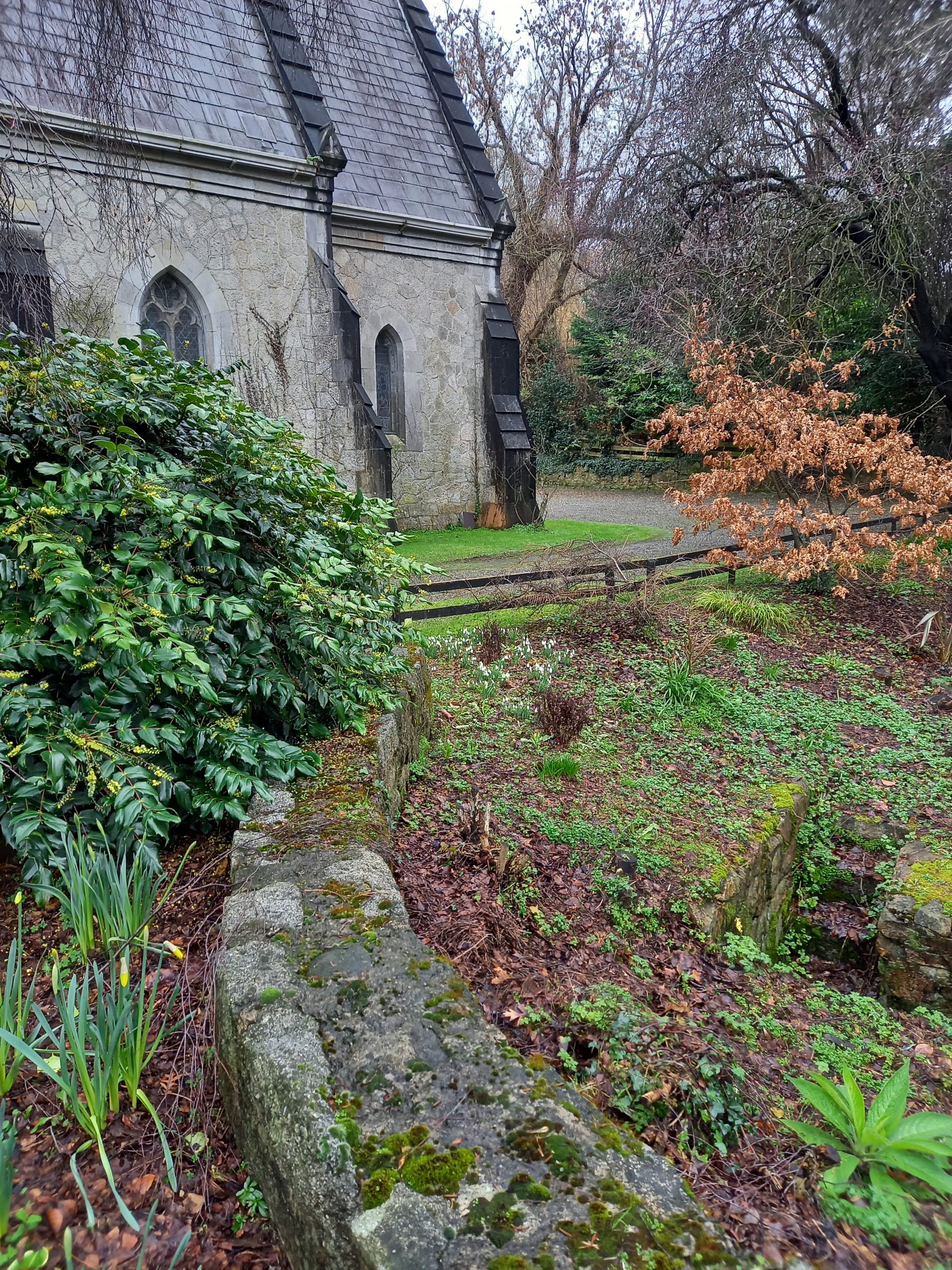Victorian Powerscourt.
It was the building of the village, many of the inhabitants of which could attend worship only in the evening, which was probably responsible for the erection of the present church, the centenary of which we are now celebrating. After the railway from Dublin to Bray was opened in 1851 the whole neighbourhood began to develop. Kilbride Church was consecrated in 1859 and Christ Church, Bray in 1863. In 1857 Elizabeth, Marchioness of Londonderry, whose first husband had been Richard the sixth Viscount, offered to the parish the magnificent present of a new church as a parting gift when she handed over her responsibilities on her son’s attaining his majority. Mervyn Edward, the seventh Viscount from 1844 to 1904, laid the foundation stone with a mallet and trowel of Wicklow silver on the day he came of age in October 1857, and a description of the day’s events may be read in the contemporary Illustrated London News. The church cost £3,441 9s. 2d. The accounts still exist and they show why the consecration was delayed until 15th September 1863. The Ecclesiastical Commissioners were not satisfied with the slated spire, and would not accept delivery from the architect, Norton of London, until a copper spire had been erected. This spire, in its turn, had to be renewed in 1929 at a cost of £1,300, as its wooden frame, which was replaced by one of Stainless steel, had perished. Despite the delay in consecration the church was opened for evening worship in 1860 at a service at which the Bishop of Labuan and Sarawak preached. When the day came for the consecration Archbishop Whately was dying, and so the ceremony was performed bt his friend Bishop FitzGerald of Kilaloe. The Church, which is dedicated to St Patrick, has since remained substantially unaltered, save that in 1875 the organ was moved to the north transept. Mervyn Richard, the eighth Viscount, who gave the lectern in 1914, donated the pulpit in 1932 in memory of his parents, and in 1946 he and Colonel Riall presented the choir stalls. The prayer desks were given in 1932 by Lord Monck in memory of his grandparents. In 1919 the chancel was altered, and instead of the old wooden rail which is now at Annacrevy, brass communion rails were put in as a War Memorial. This last fact reminds us that the background to the life of the present church has been the rivalry between Great Britain and Germany which resulted in two world wars, both of which have brought as many changes to our neighbourhood as has the invention of the motor car.
The Disestablishment of the Church of Ireland took place in 1869 not long after the building of the church. How our parish reorganised its finances, and came to grips with its new independence, may be studied in the very full minutes of the newly established Select Vestry.
These minutes record the first major task which they undertook, the building of a new rectory (now Clonderlaw) which however was sold in 1926. There is a break in the minutes from 1885 to 1895 as the current Minute Book was in the Powerscourt Arms Hotel when it was burnt down in 1894. The proprietor (one of the fifteen Mr Buckleys of the district) was the Secretary of the Select Vestry.
As a result of the first Great War changes began to take place in the neighbourhood. Britain, which had fought the war in the defence of small nations, could not, in conscience, refuse the demands of those in Ireland who were seeking, independence. One of the first laws made by the new Irish Free State government was the Land Act of 1923 by which the Irish Land Commission compulsorily bought farms from landed proprietors, and put them into the possession of the former tenants who now pay Land Annuites. In this way most of the land in the Dargle Valley passed out of the possession of Lord Powerscourt.
“The Troubles” that led up to, and that followed, the setting up of the Free State are still a living memory to many who remember how the bridge across the Dargle at Kilcroney was blown up, how the Police barracks was burnt out, and how the Parochial Hall was taken over as a police station. In 1923 Annacrevy ceased to be used as a school, although Sunday afternoon worship still continues there.
When the government vacated the Parochial Hall, in order to avoid doubts about its ownership Lord Powerscourt sold the fee simple to parish trustees, and in 1925 it was vested in the Rev W. F. Boyle, Mr C. Darlington and Mr H. Williams.
I do not propose interpreting the events of our local history since the outbreak of World War II in 1939, save to record that for half its history our parish church has served, not only our own parishioners, but also members of the Boy Scout and Girl Guide Movement, who since 1912 have been camping in Powerscourt Demesne. Their presence in church through the summer months from Easter to Harvest gives the welcome stimulus of numbers to our country congregation. For that, and, for all His other blessings to us who live in the Dargle Valley we in the Parish of Powerscourt give thanks to God in the words of the Litany which has been prayed here for nearly four centuries. “O God we have heard with our ears, and our fathers have declared unto us, the noble works that thou didst in their days, and in the old time beforethem..”
The Parish records since 1662 may be consulted in microfilm in the National Library, Dublin.
